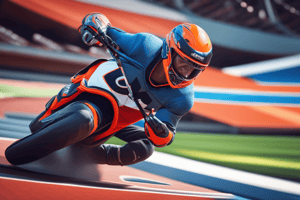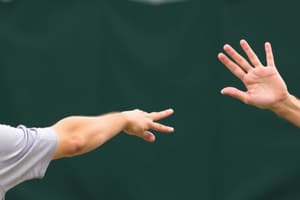Podcast
Questions and Answers
What is the primary objective of the summation of speed principle in striking and throwing actions?
What is the primary objective of the summation of speed principle in striking and throwing actions?
- To ensure that all segments reach their maximum speed simultaneously.
- To maintain equal angular speeds of all segments throughout the motion.
- To allow proximal segments to initiate movement, enhancing distal speed. (correct)
- To initiate movement with distal segments for maximum impact.
Which factor primarily influences the velocity of a struck ball in throwing actions?
Which factor primarily influences the velocity of a struck ball in throwing actions?
- The length of the throwing arm.
- The trajectory angle of the throw.
- The moment of inertia of the throwing object. (correct)
- The speed at which proximal joints rotate.
In the context of optimal movement mechanics, what does the principle of optimal coordination of partial momenta emphasize?
In the context of optimal movement mechanics, what does the principle of optimal coordination of partial momenta emphasize?
- Aligning all body segments to begin movement simultaneously.
- Prioritizing the speed of the leading limb over other segments.
- Achieving maximum speed at the distal end by synchronizing segment speeds. (correct)
- Maintaining a balanced center of gravity throughout the motion.
What balance position is suggested for the center of gravity during the leg lift phase of a baseball pitch?
What balance position is suggested for the center of gravity during the leg lift phase of a baseball pitch?
At what knee height percentage range is considered ideal for maximizing performance in pitchers?
At what knee height percentage range is considered ideal for maximizing performance in pitchers?
What happens to the center of gravity (COG) during the stride phase of pitching?
What happens to the center of gravity (COG) during the stride phase of pitching?
Which statement about the late cocking phase is accurate?
Which statement about the late cocking phase is accurate?
What characterizes the arm acceleration phase in pitching?
What characterizes the arm acceleration phase in pitching?
What occurs during the deceleration phase after ball release?
What occurs during the deceleration phase after ball release?
How much of the ball's velocity in the pitching motion is attributed to the stride and trunk rotation?
How much of the ball's velocity in the pitching motion is attributed to the stride and trunk rotation?
What is the main purpose of muscle activation in relation to angular momentum?
What is the main purpose of muscle activation in relation to angular momentum?
Which factor contributes to achieving maximum throwing speed according to the summation of speed theory?
Which factor contributes to achieving maximum throwing speed according to the summation of speed theory?
In a swing, how should bat and body masses be positioned to maximize angular acceleration?
In a swing, how should bat and body masses be positioned to maximize angular acceleration?
What is the relationship between torque and moment of inertia during a swing?
What is the relationship between torque and moment of inertia during a swing?
Which velocity conditions affect maximum ball exit speed during a hit?
Which velocity conditions affect maximum ball exit speed during a hit?
How does decreasing segment mass while maintaining momentum affect angular velocity?
How does decreasing segment mass while maintaining momentum affect angular velocity?
What principle is often associated with effective throwing mechanics?
What principle is often associated with effective throwing mechanics?
What condition should be avoided to ensure maximum momentum transfer during a strike?
What condition should be avoided to ensure maximum momentum transfer during a strike?
Which equation relates to the conservation of momentum during a baseball hit?
Which equation relates to the conservation of momentum during a baseball hit?
Which of the following is true when considering the impulse/momentum relationship during a swing?
Which of the following is true when considering the impulse/momentum relationship during a swing?
Flashcards are hidden until you start studying
Study Notes
Mechanics of Throwing & Striking
- Summation of Speed is a principle that explains how to maximize throwing/striking speed:
- Each segment reaches maximum speed at the same time.
- Proximal segments (trunk, legs) start first, transferring momentum to distal segments (arm, bat).
- Momentum is transferred to smaller masses, increasing angular velocity.
- Ex: a baseball pitch uses summation of speed, starting from the legs to the arm to the release.
- Optimal Coordination of Partial Momenta: Another key principle that emphasizes the need for coordinated movement of all body segments.
- Moment of Inertia (I): A measure of an object's resistance to rotational motion.
- During a swing, minimizing moment of inertia maximizes angular acceleration.
- Inertial Interactions: The impact of the ball on the bat can cause a decrease in the bat's speed (deceleration).
- Minimizing bat deceleration at impact increases ball exit speed.
Role of Inertia in Striking
-
Maximizing Ball Exit Speed: Depends on:
- Ball velocity before impact (slower generally better)
- Bat deceleration during impact (less deceleration better)
-
Key Considerations:
- Minimizing moment of inertia during the swing
- Ensuring the force application to the bat during impact counters deceleration (due to the ball force).
Motor Cortex (M1) and Throwing/Striking
- Primary Motor Cortex (M1): Location of voluntary motor activity.
- Cortical areas are somatotopically organized (specific areas control specific body parts).
- Representation in M1: Not proportional to body part size, but to functional demands.
- Example: Hands, fingers, and face have larger representations in the M1 because they are complex and require precise control.
- **Neuronal Activity: ** Related to specific muscles, amount of force, and movement direction.
- Neuronal activity begins about 100 milliseconds before movement onset (prep set).
- Population Vector: A way to represent the collective activity of multiple neurons in M1.
- The vector points towards the preferred direction of movement.
Cortical Pathways for Movement
- Corticospinal Tract: The main pathway from the cortex to muscles.
- Direct and fast communication to muscle groups responsible for movement.
- Plays a key role in dexterous actions (throwing, hitting).
- Neuronal Activation: The firing rate of neurons in the corticospinal tract correlates with the force and torque applied to muscles:
- This demonstrates direct control of movement.
Probing Motor System Function
- Brain Stimulation: Magnetic stimulation of the cortex can assess the integrity of the corticospinal tract.
- Activates pyramidal tract neurons (PTNs) indirectly.
- Resulting muscle twitch can be recorded, indicating pathway function.
Main Points
- Throwing/striking is a complex interplay of mechanical principles and neural control.
- The "Summation of Speed" principle is vital for maximizing throwing speed.
- Moment of inertia is crucial for maximizing bat speed and minimizing bat deceleration during contact.
- The primary motor cortex and corticospinal tract are key players in the neural control of these movements.
Studying That Suits You
Use AI to generate personalized quizzes and flashcards to suit your learning preferences.



